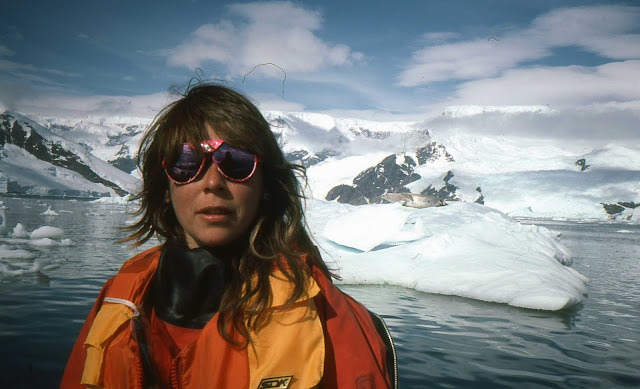Shishapagma , China
Mientras escalaba vivenciaba la montaña, sintiéndome autentica, vibrando alto para fortalecer la técnica, mi mente y la falange de mis dedos tan necesaria para escalar.
Cuando bajé me acerqué a mi compañero circunstancial, quien me estaba brindando seguro para escalar desde abajo. En ese momento alguien llamó mi atención. Era Héctor Cuiñas, con su andar tranquilo y su clásica campera fúgate color rojo, venia acercándose a la palestra con su hijo. Nunca imagine lo que estaba por ocurrir.
Lo había conocido mucho tiempo atrás a través de los comentarios de Alfredo Rosasco, con quien yo había comenzado a hacer montaña, de él había aprendido lo necesario para independizarme y seguir escalando. Era muy común conocerse por referidos en esas épocas en la actividad de montaña. Me había cruzado con Héctor en varias oportunidades principalmente en el Refugio Emilio Frey, en Bariloche. A ese lugar iban todos los instructores y cursantes del Curso de Escalada en Hielo. Todos los años el curso era organizado por el Centro Andino Buenos Aires junto con el Club Andino Bariloche, durante el verano en el Cerro Tronador, más específica
Habían pasado unos años de esto. Nos saludamos y nos pusimos a conversar, me contó que estaba armando la Expedición Argentina al Himalaya. Con la tranquilidad que siempre lo había caracterizado me preguntó si quería participar. Recién estaba conformando el grupo que iría al Shishapagma, también conocida como Gosainthan, morada de los dioses en sanscrito, una de las pocas montañas de ocho mil metros, que tiene la particularidad de estar totalmente ubicada en China, en la frontera con Nepal.
Me encantó la idea, todo andinista tiene siempre el sueño de ir a escalar al Himalaya. Yo ya había escalado el Aconcagua, la montaña más alta de América, entre otras montañas. Era el turno de los ochomiles. Todo fluía en mi vida en esos años que corrían.
"Me seducía caminar hacia las alturas de esta majestuosa montaña y contemplar desde su cima su inmensidad típica de las montañas más altas del mundo, inaccesibles para la mayoría de los mortales, colmada de mitos y leyendas que realzan su belleza. Solo existen 14 cumbres en el planeta que superan estos míticos 8.000 metros sobre el nivel del mar, siendo el Everest la más alta de todas.
Pasar a integrar ese grupo desde un comienzo del armado de la expedición, me llevó a ponerme en marcha tras ese objetivo. Me sentí halagada de estar desde un principio, no era para menos. Héctor Cuiñas, Jefe de expedición se estaba ocupando de nuclear a los integrantes de la expedición buscando un fino equilibrio entre los que teníamos amplia experiencia en montaña, como era mi caso yla de aquellos que tienen contactos para conseguir financiamiento y sponsors."
"Había comenzado la hora de aumentar mi entrenamiento, clave para ascender a la cumbre en una montaña de esa magnitud. Esto me permitiría no solo acondicionarme físicamente, sino también en lo mental. El tic tac del reloj comenzaba a correr. Estaba totalmente decidida en asumir este compromiso conmigo y con esta expedición Argentina en escalar una montaña de ocho mil metros de altura".
"Habían pasado los meses de ese verano en San Juan y el grupo había terminado por definirse para esta nueva expedición. Marcos Couch de treinta dos años, guía de montaña y socio del Centro Andino Buenos Aires, que pidió que se incorporara a Nicolás de la Cruz de veintiocho años, guía de montaña, socio del Club Andino Bariloche. Gabriel Ruiz, de veintinueve años, socio del Centro Andino Buenos Aires. Yo, Carolina Diby de veintinueve años de edad, socia del Club Andino Neuquén. Estaba contenta que también se incorporara Alfredo Rosasco, del mismo club. Alfredo no requería de presentación porque había participado de la expedición del Dhaulagiri en 1981, junto al jefe de esta expedición Héctor Cuiñas, de cuarenta y cinco años, socio del Centro Andino Buenos Aires. Al igual que Ulises Vitale, de cincuenta y ocho años, con varias expediciones en su larga lista en las montañas y en el Himalaya. Pablo Schölgl, era el director de la expedición y tenía treinta y cinco años, era instructor de montaña de la Universidad Nacional de San Juan.
También se sumaban a esta la lista Aníbal Maturano, que lo había conoció ese verano en San Juan, un excelente compañero. También estaba Flavio Lisi, y como asistentes Sergio Noguera, Avedis Naccahian y Jorge Garces.
Faltaba poco para que Pablo viajara a China. Las fechas se acercaban..."
Extractos del Libro Pasión y Aventura - capitulo Shishapagma
Some time ago I had returned from the expedition to Antarctica. One day I had gone climbing. Something inside me told me that a dream was about to come. Arrive early to the rock climbing arena of the Centro Andino Buenos Aires, an iconic wall of rock climbing practices, which was gradually growing in popularity. It had been inaugurated in 1982 and was located in the Cenard, better known as the National Center for High Performance Sports. It was the closest thing to doing a mountain in the city. The arena was made of stones irregularly placed on purpose to provide endless paths to climb. It had fissures, spurs- which are the edges of the stone from which one grabs, cracks, extra leads which means inverted scale, with the body horizontal to the ground, as if it were attached to the ceiling- and chimneys that formed between two walls . This wall allowed me and other people to practice before facing the difficulties of nature, being the closest place to climb, Sierra de la Ventana, 500 kilometers from the Autonomous City of Buenos Aires.
There it was in the rock climbing arena that was 40 meters wide and 15 high. You could feel the noise of the vehicles circulating a few meters along the Lugones highway. The sun was shining brightly, letting its rays fall on the spot, reflecting off the roughness of the stone. A fauna of climbers covered the entire wall doing their movements and practices of resistance and strength. The arena was more frequented on weekends. There was Marcos Couch, with long hair and a beard, which reminded me of a European climber, he was an expert mountaineer with a long career giving a course with Kako, you could see the ropes, the carabiners, the harnesses piled up in some corners, hanging hammocks in the part
interior of the arena, which is a hole simulating the mountain, climbers like spiders climbing the wall with their fingers covered with magnesium making an effort in their practice and the inevitable dunk wheel of some resting. Laughter, conversations, music were
some of the things that reflected that magical camaraderie that exists in the urban rock climbing environment.
While climbing I experienced the mountain, feeling authentic, vibrating high to strengthen the technique, my mind and the phalanx of my fingers so necessary to climb.
When I got down I approached my circumstantial partner, who was giving me insurance to climb from below. At that moment someone caught my attention. It was Héctor Cuiñas, with his calm walk and his classic red fugue jacket, he was approaching the arena with his son. I never imagined what was about to happen.
I had known him a long time ago through the comments of Alfredo Rosasco, with whom I had begun to hike, from him I had learned what was necessary to become independent and continue climbing. It was very common to be known by referrals in those times in mountain activity. I had come across Héctor on several occasions, mainly at the Emilio Frey Refuge, in Bariloche. All the instructors and students of the Ice Climbing Course went to that place. Every year the course was organized by the Centro Andino Buenos Aires together with the Club Andino Bariloche, during the summer at Cerro Tronador, more specifically
It had been a few years of this. We greeted each other and began to talk. He told me that he was putting together the Argentine Expedition to the Himalayas. With the calm that had always characterized him, he asked me if he wanted to participate. He was just forming the group that would go to the Shishapagma, also known as Gosainthan, abode of the gods in Sanskrit, one of the few mountains of eight thousand meters, which has the peculiarity of being totally located in China, on the border with Nepal.
I loved the idea, every mountaineer always has the dream of going to climb the Himalayas. I had already climbed Aconcagua, the highest mountain in America, among other mountains. It was the turn of the eight thousand. Everything flowed in my life in those running years.
"It seduced me walk toward the heights of this majestic mountain and gaze from its summit typical immensity of inaccessible to most mortals, full of myths and legends highest mountains in the world that enhance its beauty. There are only 14 summits the planet that exceed these mythical 8,000 meters above sea level, with Everest being the highest of all.
To become part of that group from the beginning of the expedition's assembly, led me to set out after that objective. I was flattered to be there from the beginning, it was no wonder. Héctor Cuiñas, Expedition Chief, was taking care of the members of the expedition nuclear power, seeking a fine balance between those of us who had extensive experience in the mountains, as was my case, and those who have contacts to obtain financing and sponsors. "
"It was time to increase my training, the key to ascending to the top of a mountain of that magnitude had begun. This would allow me not only to condition myself physically, but also mentally. The ticking of the clock began to tick. I was totally determined in assume this commitment with me and with this Argentine expedition in climbing a mountain eight thousand meters high .... "
"The months of that summer had passed in San Juan and the group had finally defined itself for this new expedition. Marcos Couch, thirty-two years old, a mountain guide and member of the Centro Andino Buenos Aires, who asked that Nicolás de la Cruz, twenty-eight years old, mountain guide, member of the Club Andino Bariloche. Gabriel Ruiz, twenty-nine years old, member of the Centro Andino Buenos Aires. I, Carolina Diby, twenty-nine years old, member of the Club Andino Neuquén. Alfredo Rosasco, from the same club, should join. Alfredo did not require an introduction because he had participated in the Dhaulagiri expedition in 1981, together with the head of this expedition Héctor Cuiñas, forty-five years old, a member of the Centro Andino Buenos Aires. Like Ulises Vitale, fifty-eight years old, with several expeditions on his long list in the mountains and in the Himalayas. Pablo Schölgl, was the director of the expedition and was thirty-five years old, he was an instructor of mon taña of the National University of San Juan.
Also joining this list were Aníbal Maturano, who had met him that summer in San Juan, an excellent companion. There was also Flavio Lisi, and as assistants Sergio Noguera, Avedis Naccahian and Jorge Garces.
It was just a short time for Pablo to travel to China. The dates were getting closer ... "
Excerpts from the Book Passion and Adventure - Shisha Pangma chapter
WhatsApp : +5492942473284
explorapatagoniatrek@gmail.com
Podes retirarlo EN NEUQUEN capital en el negocio "Tenis Tenis" en Avenida 25 de mayo 79. a una cuadra del Palacio Municipal de Neuquén. Horario: de lunes a viernes 10:00 a 12:30 de la mañana y de 17:00 a 18:00 por la tarde. y Sábado solo de mañana.
A partir del mes de JULIO EN LIBRERIA LIBRACOS DE NEUQUEN capital.
EN BUENOS AIRES capital en Editorial Cruz Pampa / Filo Sur. Rivadavia 1255 piso 3 oficina (entre Libertad y Talcahuano) Ciudad Autónoma de Buenos Aires Tel. (011) 4381-9675






Comentarios
Publicar un comentario